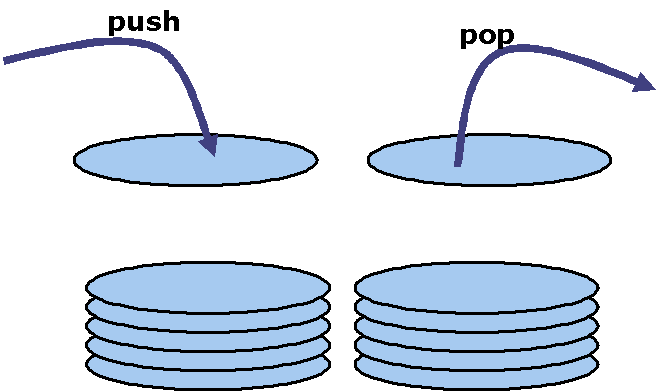This activity uses a linked list to implement a stack data structure.
In addition to the Solution document, the project for the activity contains the following items:
The data structure called a stack is fundamental in computing. Stacks are last-in-first-out structures. You can think of one as being like a pile of plates. The plates can only be added to, or removed from, the top of the structure.
Traditionally, the operation to add an item to the top is called push, and the one to remove the top item is called pop.

We also have an operation peek, which sneaks a look at the top item but does not remove it, and isEmpty, which returns the value true if the stack has no items in it. The isEmpty operation is there so that clients wanting to use the stack can check that it is not empty before they try to pop something off it!
The reason for the importance of stacks is that they model the situation where a system is in the middle of one task when it discovers that it needs to divert to a second one.
To deal with this, the original job is pushed on a stack. Later, when the second task is complete, the original one is popped from the stack and resumes at the point where it left off.
Of course the second task might be interrupted by a third one, and so on. But eventually a task will complete, and then the previous one can resume, then the one before that, and so on all back down the chain. There might be further interruptions along the way, but in the end all the jobs will be popped back off the stack again, in the reverse order to the one that they were pushed on in, and execution will be complete.
A typical situation where a task will be pushed on a stack is where one method invocation causes another to be invoked. The position reached by the first method will be placed on a stack before the second method invoked. When the second call returns the first method will be popped from the stack and continue execution from the point at which it stopped previously.
As a first step towards implementing a stack in Java we have defined an interface which contains abstract methods corresponding to these four operations.
public interface Stack
{
public void push(Object o);
// Adds an item to the top of the stack.
public Object pop();
// Removes an item from the top of the stack.
public Object peek();
// Returns the item on the top of the stack,
// but does not remove it.
public boolean isEmpty();
// Answers true if the stack is empty.
}
This could be implemented in many different ways. For example, it would be possible to use an array, or an array list. You are asked to write an implementation of this class using a linked list, which is a particularly suitable structure to base a stack on.
Complete LinkedStack where indicated by comments. The elements of the stack should be of type Object.
Run the project and check that the output is as you expected.